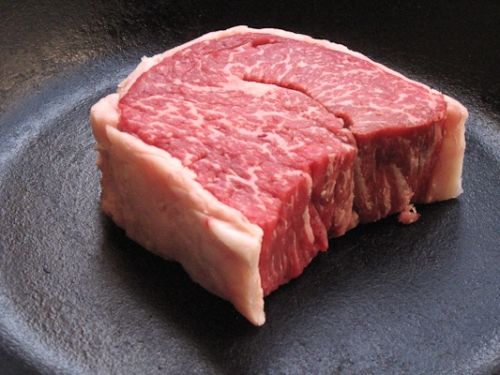Tucked away on a small street in New York City’s Greenwich Village there is a butcher shop called Florence Meat Market which opened in 1936 and doesn’t seem to have changed much since. There is sawdust scattered on the floor and all the meat is cut to order on big cubes of butcher block. These expert butchers know every cut and preparation, including some you’ve never heard of.
Florence Meat Market was opened by Jack Ubaldi, an Italian immigrant who learned the art of butchery at his father’s knee. He owned the shop until about 1975 when he sold it to Tony Pellegrino, a man he had trained himself. In 1995 Mr. Pellegrino passed it on to another Florence-trained expert, Benny Pizzuco, who still owns it today. It is this apprenticeship system that has allowed Florence to maintain such a high quality. According to Mr. Pizzuco they don’t hire butchers at the shop, everyone starts out wielding a broom and works their way up.
Obviously, Mr. Ubaldi knew his animals and how to break them down into any number of component parts. In fact, he knew them so well that he went so far as to invent a new cut of steak. In the 1940s Greenwich Village was a magnet for artists of all kinds. Then as now, they didn’t always have a lot of money left to buy food after paying the rent. Mr. Ubaldi hit upon a small, flavorful steak cut from the bottom butt of the cow. The bottom butt is an inexpensive cut and so these steaks could be sold relatively cheaply. They are shaped a bit like the crescent moon, but with the two tips folded towards each other. It is nicely marbled and comes with a lovely layer of fat around the outside.
In addition to being a good butcher, Mr. Ubaldi was a smart businessman. He knew that for this new steak to sell it had to have a good name. One day, while watching an ad for Newport cigarettes he realized that the steak (especially before it is folded together) looked a lot like the Newport logo. Thus was born the Newport Steak.
Some say it is simply a tri-tip steak which is a very popular cut in California. However, Benny Pizzuco insists that it is more than just that, but of course he would never reveal the secret. That said, some other New York butchers sell Newport Steaks, but none know the secrets of the Florence way of cutting and trimming them, so maybe they’re not real Newports? Or maybe it’s just good marketing. I suppose we’ll never know.
The Newport Steak is the perfect New York steak for several reasons. Many New Yorkers live alone and cook for one. The Newport is small, weighing only about a pound or less, well marbled, and since all of Florence’s meats are dry aged for up to three weeks, it’s very flavorful. While I’m sure Mr. Pizzuco’s Porterhouse steaks are amazing, it’s also nice to be able to get a small high quality steak for a good price.
The Newport is also very well suited to my favorite method of cooking steak in a New York apartment. If you live here, you most likely have a tiny, ill-ventilated kitchen, with a smoke detector right nearby. That means that cooking steak is an exercise in opening windows and positioning portable fans, and perhaps explaining to the neighbors that no, you are not on fire, just cooking steak.
Through consultation with my fellow Gothamites and the advice of the supremely helpful discussion boards over on egullet.org, I’ve developed a way to avoid all of that and still wind up with a pretty good steak. You’ll find full instructions below, but the important parts are heating your pan in the oven so it doesn’t smoke, searing the steak on the stove top for a minimal amount of time to avoid the smoke detector, and then finishing the steak in the oven for the same reason. The result may not be quite what you’d get in a restaurant, but if you start out with a $7.99 per pound Newport and cook it yourself, it’s a heck of a lot cheaper.
New York Apartment Steak
Serves 2
2 Newport Steaks from Florence Meat Market
Kosher salt
Black pepper
Cooking twine
Season your steaks liberally with kosher salt and black pepper. Allow them to stand on the counter until they come to room temperature.
Preheat your oven to 400F.
Place a large cast iron pan in the oven for at least 15 minutes before beginning to cook the steaks.
Tie a piece of cooking twine around the circumference of each steak. This will help it hold it’s shape during cooking, and it will cook more evenly.
When the cast iron pan is good and hot, carefully (!) move it to the stove top over medium-high heat. Place the prepared steaks in the pan and cook them for 2 minutes per side.
Move the cast iron pan with the steaks in it back to the oven and cook them there for 4½ minutes. Remove the pan from the oven, move the steaks to a plate, and let them rest for 5-10 minutes before serving.
You could make a pan sauce if you like, or serve each one with a pat of homemade tarragon butter on top. Me, I like them as is, with a side of buttery mashed potatoes.



























